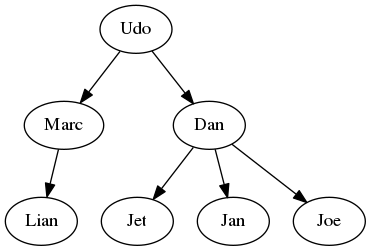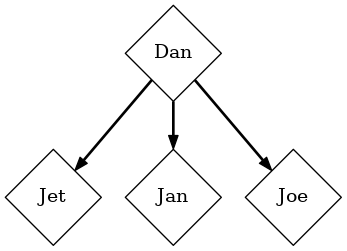




- Documentation
- PyPI
- GitHub
- Changelog
- Issues
- Contributors
- If you enjoy anytree

Usage is simple.
Construction
>>> from anytree import Node, RenderTree
>>> udo = Node("Udo")
>>> marc = Node("Marc", parent=udo)
>>> lian = Node("Lian", parent=marc)
>>> dan = Node("Dan", parent=udo)
>>> jet = Node("Jet", parent=dan)
>>> jan = Node("Jan", parent=dan)
>>> joe = Node("Joe", parent=dan)Node
>>> print(udo)
Node('/Udo')
>>> print(joe)
Node('/Udo/Dan/Joe')Tree
>>> for pre, fill, node in RenderTree(udo):
... print("%s%s" % (pre, node.name))
Udo
├── Marc
│ └── Lian
└── Dan
├── Jet
├── Jan
└── JoeFor details see Node and RenderTree.
nLine
Create tree model of the electrical grid. Each node has a failrate. When you refresh the tree, if a parent fails, the failure propagates to all the children and the children's children, etc. Very primitive for now! More functionality coming. Update: failrate defaults to zero and you an set a node's status. When you use setstatus the sub-tree is refreshed.
>>> from anytree import Node, RenderTree
>>> prim = Node("Prim", failrate=50)
>>> seco = Node("Seco", failrate=20)
>>> seco = Node("Seco", failrate=20, parent=prim)
>>> sensor = Node("Sensor", failrate=0, parent=seco)
>>> tinytim = Node("Tiny Tim", failrate=0, parent=seco)
>>> seco2 = Node("Seco2", failrate=90, parent=prim)
>>> giulio = Node("Giulio", failrate=0, parent=seco2)
>>> for pre, fill, node in RenderTree(prim):
... print("%s%s %s" % (pre, node.status, node.name))
...
1 Prim
├── 1 Seco
│ ├── 1 Sensor
│ └── 1 Tiny Tim
└── 1 Seco2
└── 1 Giulio
>>> seco.setstatus(0)
>>> for pre, fill, node in RenderTree(prim):
... print("%s%s %s" % (pre, node.status, node.name))
...
1 Prim
├── 0 Seco
│ ├── 0 Sensor
│ └── 0 Tiny Tim
└── 1 Seco2
└── 1 GiulioVisualization
>>> from anytree.exporter import DotExporter
>>> # graphviz needs to be installed for the next line!
>>> DotExporter(udo).to_picture("udo.png")The DotExporter can be started at any node and has various formatting hookups:
>>> DotExporter(dan,
... nodeattrfunc=lambda node: "fixedsize=true, width=1, height=1, shape=diamond",
... edgeattrfunc=lambda parent, child: "style=bold"
... ).to_picture("dan.png")There are various other Importers and Exporters.
Manipulation
A second tree:
>>> mary = Node("Mary")
>>> urs = Node("Urs", parent=mary)
>>> chris = Node("Chris", parent=mary)
>>> marta = Node("Marta", parent=mary)
>>> print(RenderTree(mary))
Node('/Mary')
├── Node('/Mary/Urs')
├── Node('/Mary/Chris')
└── Node('/Mary/Marta')Append:
>>> udo.parent = mary
>>> print(RenderTree(mary))
Node('/Mary')
├── Node('/Mary/Urs')
├── Node('/Mary/Chris')
├── Node('/Mary/Marta')
└── Node('/Mary/Udo')
├── Node('/Mary/Udo/Marc')
│ └── Node('/Mary/Udo/Marc/Lian')
└── Node('/Mary/Udo/Dan')
├── Node('/Mary/Udo/Dan/Jet')
├── Node('/Mary/Udo/Dan/Jan')
└── Node('/Mary/Udo/Dan/Joe')Subtree rendering:
>>> print(RenderTree(marc))
Node('/Mary/Udo/Marc')
└── Node('/Mary/Udo/Marc/Lian')Cut:
>>> dan.parent = None
>>> print(RenderTree(dan))
Node('/Dan')
├── Node('/Dan/Jet')
├── Node('/Dan/Jan')
└── Node('/Dan/Joe')Extending any python class to become a tree node
The enitre tree magic is encapsulated by NodeMixin add it as base class and the class becomes a tree node:
>>> from anytree import NodeMixin, RenderTree
>>> class MyBaseClass(object): # Just an example of a base class
... foo = 4
>>> class MyClass(MyBaseClass, NodeMixin): # Add Node feature
... def __init__(self, name, length, width, parent=None, children=None):
... super(MyClass, self).__init__()
... self.name = name
... self.length = length
... self.width = width
... self.parent = parent
... if children:
... self.children = childrenJust set the parent attribute to reflect the tree relation:
>>> my0 = MyClass('my0', 0, 0)
>>> my1 = MyClass('my1', 1, 0, parent=my0)
>>> my2 = MyClass('my2', 0, 2, parent=my0)>>> for pre, fill, node in RenderTree(my0):
... treestr = u"%s%s" % (pre, node.name)
... print(treestr.ljust(8), node.length, node.width)
my0 0 0
├── my1 1 0
└── my2 0 2The children can be used likewise:
>>> my0 = MyClass('my0', 0, 0, children=[
... MyClass('my1', 1, 0),
... MyClass('my2', 0, 2),
... ])>>> for pre, fill, node in RenderTree(my0):
... treestr = u"%s%s" % (pre, node.name)
... print(treestr.ljust(8), node.length, node.width)
my0 0 0
├── my1 1 0
└── my2 0 2Please see the Documentation for all details.
To install the anytree module run:
pip install anytree
If you do not have write-permissions to the python installation, try:
pip install anytree --user

